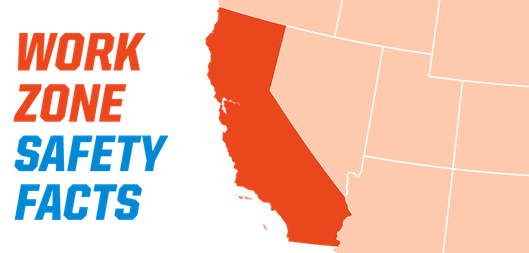Work Zone Safety
Caltrans’ highest priority is safety. Caltrans employees repair and maintain California’s 50,000 highway lane miles, 12,000 bridges, 205,000 culverts and drainage systems, 87 roadside rest areas, and 30,000 acres of roadside landscaping.
Caltrans continues to increase its efforts to make highway work areas safer for Caltrans employees, highway workers, and the motoring public. Caltrans is focused on educating motorists about safe driving in and around works zones.
What is a Work Zone?
A work zone is an area of a highway or roadway with construction, maintenance, or utility-work activities. A work zone is typically marked by signs, cones, barrels, channeling devices, barriers, pavement markings, and/or work vehicle. It extends from the first warning sign or flashing lights on a vehicle to the "End of Road Work" sign or the last traffic control device. A work zone may be for short or long durations, and may include stationary or moving activities.
What should you do when approaching a work zone?
Construction and maintenance activities close to the road involving workers and equipment can be very distracting.
You should always:
- Stay alert and be aware of your surroundings. Dedicate your full attention to the roadway.
- Pay close attention. Signs and work zone flaggers save lives.
- Merge early.
- Avoid distractions. Avoid changing radio stations and using mobile phones while driving in the work zone.
- Don’t speed. Speed is the number one contributing factor in work zone crashes.
- Expect the unexpected. Keep an eye out for workers and their equipment.
- Allow ample space between your vehicle and the car in front of you.
- Move Over when you see flashing amber lights.
- Be patient. Remember the work zone crew members are working to improve your future.
Why is "tailgating" extremely dangerous in a work zone?
Most rear-end crashes occur when cars follow too closely. They do not have enough room to stop. You need at least 2.5 seconds to react and one second for every 10 MPH you are traveling. If you are traveling at 55 MPH in a work zone, you need at least eight seconds to stop.
What is the penalty for speeding in a work zone?
Fines are doubled in highway work zones. They can easily total $1,000 or more for drivers who speed, drive aggressively, text, or are otherwise distracted driving through a work zone.
Why should you slow down when you don't see anyone working?
Physical hazards-such as traffic shifts or lane reductions-may be present. Obey the posted speed limit.
Highway Work Zone Facts:
- Drivers and passengers are at even greater risk than highway workers. Eighty-five percent of those killed in a work zone are drivers and/or passengers.
- There aren’t always cones around a highway work zone.
- Many highway workers do their job outside a barricade entirely – such as landscape work, litter detail, sweeping, or clean up.
- Vehicles crashed into 45% of highway work zones in 2013.
- In 2014, latest recorded statistics, there were 6,525 work zone crashes on California highways.
For additional work zone information, please visit:
Federal Highway Administration:
http://safety.fhwa.dot.gov/wz/
http://www.ops.fhwa.dot.gov/wz/resources/facts_stats.htm
Work Zone Clearing House:
http://www.workzonesafety.org/







